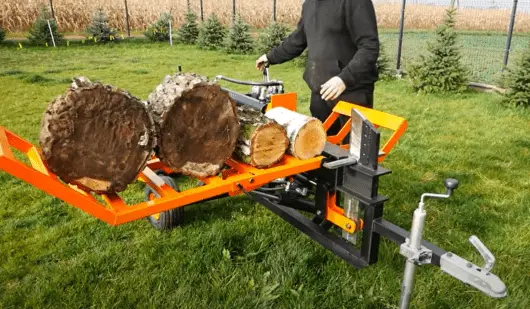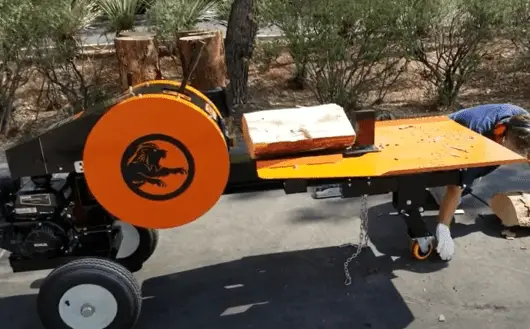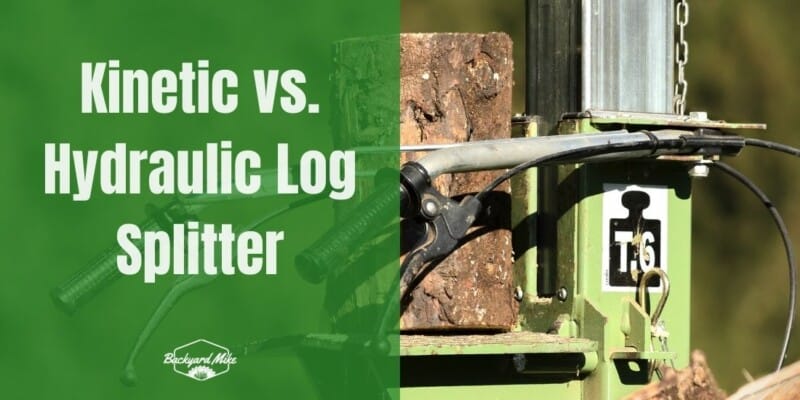If you are in the market for a log splitter, you will find three different types; hydraulic, kinetic, and manual log splitters.
While it’s easy to differentiate the manual type from the other two types, it can be hard to decide between kinetic and hydraulic types. So, what’s the difference between kinetic vs hydraulic log splitters?
This guide will walk you through a detailed comparison of kinetic versus hydraulic log splitters and how to pick one. Before we jump to the differences, let’s first find out how each works.
Hydraulic Log Splitter

Hydraulic log splitters are the most popular and common type of wood splitters. They are efficient, powerful, and reliable.
There are two types of hydraulic log splitters
- Gas-powered
- Electric powered
Hydraulic log splitters have a hydraulic system that pushes the log to the blade. The hydraulic system is powered by a pump that is powered by either an engine or a motor.
Parts of a hydraulic log splitter
- Hydraulic system (hydraulic fluid tank, pump, hydraulic cylinder, control valve, and hoses)
- Wood splitter/wedge
- Power source or motor
When you start the log splitter, this will power the hydraulic system, and the hydraulic fluid will start flowing throughout the system.
ALSO READ: What type of hydraulic fluid for log splitter
To split the wood, you will have to activate the hydraulic cylinder via a valve. The hydraulic cylinder then pushes the wood and shoots it towards the blade, cutting it in two. Other splitters move the blade towards the log. In both scenarios, the engine is connected to a pump that contains hydraulic fluid. The hydraulic fluid pump creates a high-pressure stream of oil that travels to the valve.
Pros
- Horizontal to vertical log placement positions
- More powerful than kinetic splitters
- Older and refined technology
- Cheaper
Cons
- Slower than kinetic splitters
Kinetic Log Splitter

Unlike a hydraulic log splitter that uses hydraulic pressure to push the blade or log, a kinetic log splitter uses kinetic energy to push the blade or log. Just like their hydraulic counterpart, the kinetic system is either gas or electric powered.
RELATED: Best Kinetic Log Splitter – Top-Performing Products Review
Even though kinetic log splitters aren’t as standard as hydraulic splitters, they work just as well. They are fast and powerful, so it doesn’t matter the thickness or age of the log; it will work outstandingly.
As to how they operate, they use kinetic energy, as the name implies. Rather than hydraulics, their system uses the stored kinetic energy produced when the fly discs are spinning in the form of rotational energy. When the discs accelerate, it releases the kinetic energy stored to push the logs into the blade.
As opposed to the hydraulic systems, the energy collected is all released at once, which allows it to slice through different log sizes.
Pros
- Very easy to maintain
- They are faster
- Easy to assemble
Cons
- Not as powerful
- Pricier
- Bulkier
Features and Differences Between Hydraulic and Kinetic Splitters
Now that we’re familiar with kinetic and hydraulic log splitters and how they operate, we can dive into their features and differences to see what they offer.
Power
Hydraulic log splitters are more powerful than kinetic splitters. If you’re chopping big and bumpy logs, you should consider a hydraulic log splitter. They can be rated at 35 tons or more of force and cut anything you present to them. With that being said, kinetic log splitters can also pass through hardwoods.
How powerful a hydraulic splitter is depends on whether it’s electrical or gas-powered. Gas-powered models can handle logs up to 12” diameter and 20” long.
Kinetic log splitters are not measured in tons of force like hydraulic splitters. This is because their power is sent in a short sharp blast, so it’s not possible to give them a tonnage rating either. Manufacturers instead match them up to equivalent hydraulic units and use that to rate them in tonnage. But their power has its benefits, and one of them is that their explosive force helps them slice through hard logs than an equivalent hydraulic unit.
Speed
Like power, speed is also a crucial factor when looking into kinetic and hydraulic splitters. A hydraulic splitter has a cycle time of 10 – 30 seconds typically. This cycle time is taken to slice a log and return it to its position. On the other hand, a kinetic log splitter has a cycle time of 2 – 3 seconds. That is one big difference in speed.
There’s not much we can say on speed, but the fact remains, if you’re looking for speed, you can’t compare a kinetic splitter to any log splitter. You’ll split a lot more logs in a short period by using a kinetic log splitter.
Maintenance
Both kinetic and hydraulic require maintenance, but a kinetic log splitter requires less. If you’re using a kinetic log splitter, you need to keep the bearings clean for a smooth operation. Sap and dirt in the bearings will damage your splitter with time.
As for the hydraulic log splitter, it requires more attention. You need to keep it clean, check the hydraulic fluid for contaminates, drain the filter from time to time, and replace the oil (after 150 hours of use). You might also need to check on the hoses and maybe replace them if they are fragile (but that might be after years of service)
Safety
Both log splitters use a lot of force and both should be handled carefully. Ensure you have safety gear and are capable of using the machine. But hydraulic splitters are a lot safer. It is basically about speed. With a head start of more than ten seconds per cycle, you can quickly get your hands or anything else out of the way before it returns.
With a kinetic log splitter, the cycle time is much faster; you don’t have much time to get something where it isn’t supposed to be. Additionally, if you aren’t working alone, be extra careful to communicate in advance, and the person operating should always know where the others are.
Note:
After choosing the type, you will then choose between electrical and gas-powered models. For instance, gas-powered hydraulic splitters are more powerful than electrical-powered hydraulic splitters, but they are noisier and pricier.
Wrapping up
And that’s it for kinetic log splitter vs. hydraulic – understanding the difference will help you choose the one that aligns with your needs. If it is the speed you want above anything else, you should go for a kinetic log splitter. However, go with the hydraulic log splitter if it’s the power you’re looking for. Whichever you prefer, with proper maintenance, you can have a machine that will save you time and struggle for many years.
Frequently Asked Questions
Which is better, hydraulic log splitter or kinetic log splitter?
It will depend on what you want; less maintenance, more power, speed? Hydraulic splitters are more powerful and cheaper, while kinetic models are faster but expensive, but both of them work great.
What is special about gas-powered hydraulic splitters?
Log splitters powered by gas are more powerful than electrical-powered models. Hydraulic log splitters also allow you to switch between vertical and horizontal, which sometimes can be a problem when splitting larger and heavier logs.


